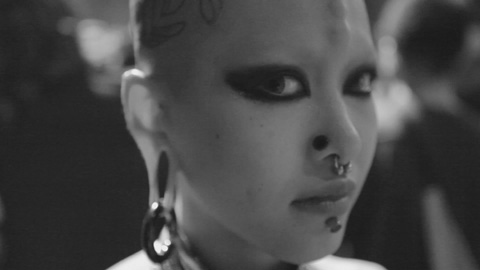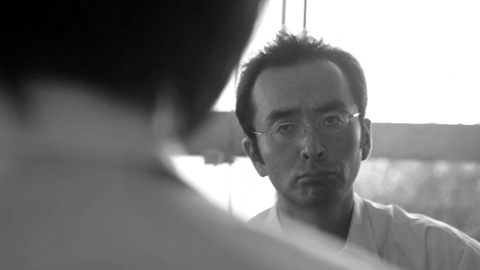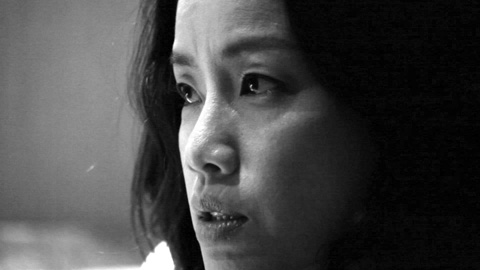GFP Bunny
- Year
- 2012
- Original title
- GFP BUNNY Tariumu Shojo no Puroguramu
- Japanese title
- GFP BUNNY タリウム少女のプログラム
- Alternative title
- タリウム少女の毒殺日記/gfp bunny
- Director
- Cast
- Running time
- 82 minutes
- Published
- 5 December 2012





by Jasper Sharp
It really does seem like an awfully long time since we were all excited about Yutaka Tsuchiya's last film, Peep "TV" Show – the talking point, I recall vividly, of the 2003 Yamagata International Documentary Film Festival where it premiered. Frustratingly, since this, aside from a producer’s credit on Hiroki Iwabuchi’s A Permanent Part-Timer In Distress (Sonan Furita, 2008), a personal video diary of a young college graduate yet to make it even to the bottom rung of the career ladder, there’s been nary a blip of activity from one of the most consistently interesting indie filmmakers in Japan. Until now.
The world of jishu eiga has been noticeably the poorer for this absence. For a large part of the past decade, this passionate, self-sustaining enclave of highly personal DIY filmmaking has provided some of Japan's most insightful, enlightening and innovative contributions to the world of cinema. In recent years, however, it seems largely to have descended into a morass of torpid, witless, self-indulgent cliquishness. Passion has become an excuse for amateurishness, with words such as "auteur" and "cineaste" all too readily applied to some of the more conspicuous camcorder onanists.
Over the past couple of years, keeping up with the zero-budget DV-shot glut that has been snowballing since the turn of the millennium, just in order to unearth the occasional gem, has become almost unbearable. One often gets the feeling that most of the people making films in this sector seem to be doing so only because they want to be labeled "filmmakers", not because they have anything of interest to say nor new ways of framing familiar arguments. In a world saturated with moving images, they often have little new to bring to the table, seeming content to retell the same old stories over and over again and using the most rudimentary of video production techniques. As Midnight Eye’s own Nick Rucka observed back in 2010:
"Let's not forget the point of movies: the power of a good story. We seek out films that touch us in a way that's unexpected and helps us somehow contextualize and understand our lives or to entertain us and help us escape for a moment from it. Therefore there's nothing worse than watching a film that feels like a missed opportunity - except, of course, for a film that you feel like you've seen a million times before."
So that brings us back to Tsuchiya’s long overdue return. An idiosyncratic melding of drama and documentary techniques in a not dissimilar vein to Peep "TV" Show, GFP Bunny is ostensibly based on a true story of a high-school girl who began systematically poisoning her mother with thallium. However, what are meant by both the words "true" and "story" is constantly called into question in more ways than just the overtness of the reenactment, as key events recorded in the perpetrator’s diaries are restaged from Shizuoka in 2005 to Tokyo in 2011 in a way that actively rejects drama.
As we scrutinize the actions of "Thallium Girl" with the same clinical detachment with which she, for example, unflinchingly videos the still-beating heart she has removed from a recently dissected frog and uploads her footage to YouTube, the narrative is largely shaped by the internal monologue of our anonymous subject and the off-screen commentary of Tsuchiya the director, adopting the authoritative voice-of-god role of the science documentary. Occasionally she interjects with the rebuttal that there is no story to tell here. At the film’s coda she finally introduces herself as Yuka Kuramochi – subsequently revealed in the end credits to be the name of the actress playing the girl rather than the girl herself – in a voice that is clearly quite different from the one we have been hearing attributed to her all along.
Such distantiation techniques are more than just explorations of narrative / documentary form. Tsuchiya has remarked that the content and structure of the film were informed by this meticulous journal-keeping that accompanied the real-life administration of thallium to her only apparent family member, who in the film is played by Makiko Watanabe, another in a line of appearances by this actress as a screwed-up, domineering mother to an equally screwed-up adolescent daughter familiar from such films as Sion Sono’s Love Exposure (Ai no Mukidashi, 2009) and Hisayasu Sato’s Love and Loathing and Lulu and Ayano (Namae no nai Onnatachi, 2010). In fact, the film’s initial Japanese title (before it was rechristened for its unveiling at the Tokyo International Film Festival) literally translates as "Thallium Girl’s Poisoning Diary / gfp bunny", the second half of which refers to a real-life genetically-engineered rabbit created in France in 2000 that actually glows in the dark under certain types of illumination. Science is indeed weirder than fiction in Tsuchiya’s world, and bears a similarly problematic relationship with "reality".
Thallium Girl, who suffers from a degree of schizophrenia and is the victim of severe classroom bullying, is very much caught up in her own reality, methodically recorded through her camera as she wanders around her local neighborhood filming ants and other insects with the same dispassionate objectivity as she does buildings, communications pylons, traffic and shopping mall food halls. She kicks a dog at one point just to see if it barks, and monitors the ongoing effects of the thallium on her mother with reference to a second subject, a caged hamster kept in her room. All of her filmed observations are then uploaded to the internet, leaving for posterity a chilling record of her daily life surrounding her mother’s systematic murder, similar to the impassive postcard images that comprise Masao Adachi’s A.K.A. Serial Killer (Ryakusho: Renzoku Shasatsuma, 1969) of the locations visited by the "Serial Gun Killer" Norio Nagayama who went on a murderous spree in the late 1960s (see also Kaneto Shindo’s Live Today, Die Tomorrow,).
Tsuchiya, in a nice piece of multimedia jokery that I’ll leave the reader to discover for themselves, cleverly invokes these brief video clips to extend the Thallium Girl mythos, claiming that her original footage can still be seen on YouTube, uploaded under the alias Krausecorpuscle. While Peep "TV" Show presciently posited a pre-YouTube pre-social media generation desperate to assert their identity within a domineering media landscape by making spectacles of their lives for others to consume, GFP Bunny unfolds in a world where this internet-mediated reality has become the norm, a crucial part of modern-day social interaction and self-expression.
Thallium Girl seems barely conscious of the schoolyard tyranny she is subjected to by her peers unless through the blurry pixelated happy-slapping videos she sees on the web, the victims’ faces mosaicked out. The leering, pornographic gaze afforded to her at school by her only superficially-concerned teacher is framed in a similar way to the appetizing menu of Webcam girls appearing in separate video windows on the "love love live" website, which Thallium Girl also joins. Vital fleshy bodies represented by digital arrays disseminated by computer networks across the world continue the film’s juxtaposition between objective systems of knowledge and a subjective earthly reality.
GFP Bunny unfolds as a patchwork of dramatized scenes interspersed with footage of scientific experiments, vox-pop interview fragments with the general public about such subjects as cosmetic surgery, and new media visualisations of its protagonist’s immediate world by way of CGI architectural models and Google Earth images. A white-coated scientist appears in a direct-to-camera interview about a breed of genetically engineered transparent frogs that don't need to be killed in order to reveal their metabolic secrets, one of several experts who pop up almost as a Greek chorus to contextualise Thallium Girl’s increasingly abstract thought patterns, as mind and body become more distinct and the voices in her head escalate to a deafening clamour. Elsewhere we have lessons in the cultivation of human transplant organs from pigs, a genetics 101 from a member of the Raelian UFO sect, and a grueling sado-masochistic workout from a body modification artist with full body tattoos, facial piercings, and Klingon-like bumps implanted in her forehead.
The above should give some indication of but a small selection of the barrage of ideas that Tsuchiya has been storing up over the past 7 years in his ongoing project of redefining a reality through each new iteration of technology. A film as provocative and discomforting as it is rich and thought-provoking, I won’t pretend GFP Bunny is an easy watch by any means. Nevertheless, within a succinct 82 minutes, Tsuchiya has singlehandedly rekindled my faith in the future of Japanese cinema to engage with sophisticated ideas in a progressive fashion and to delve deep beneath the skins of its subjects.